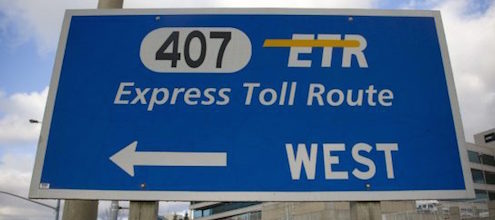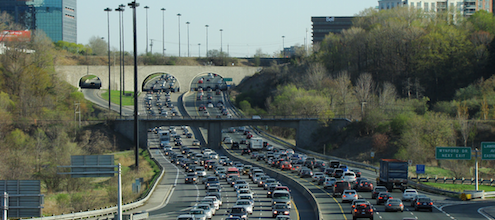
How varied road tolls can reduce congestion: A closer look at Highway 407 in Ontario
Last November the Ecofiscal Commission released its report on congestion pricing in Canadian cities. Road congestion is getting worse in many Canadian cities—big and small—and we believe that congestion pricing is the crucial and missing piece of a broader, coordinated package of policies to improve urban mobility. Momentum is already underway: the Ontario government is moving ahead with implementing high-occupancy tolled lanes on a number of provincially owned highways, and the City of Ottawa is considering whether it will commission a feasibility study on congestion pricing. We take this opportunity to take a deeper dive into one of the case studies from our November report, which looks at how time-of-day pricing can reduce peak travel times. For this, we look no further than highway 407 in the Greater Toronto Area (GTA).
Tolls were used to first finance construction and, second, to reduce congestion
The Ontario government built Highway 407 to help deal with worsening road congestion on Highway 401 in the Greater Toronto Area. Due to financial constraints, the provincial government built the 407 ETR (Express Toll Route) as a tolled facility to finance its construction, and sold the highway as a concession soon after its opening. Tolling began in October 1997, making the 407 ETR the first open-access, all-electronic toll highway in the world. The highway stretches from Burlington in the south-west, across the GTA, and to Pickering in the east.
The 407 ETR turned out to be a popular choice among commuters. Due to high demand, the structure of the toll evolved to include variable pricing, which means that people pay higher prices to travel during peak times, and lower prices during off-peak times. This encourages people with greater flexibility to drive during off-peak times, or to find a different route—which decreases congestion on the 407 and ensures faster and more reliable travel times. The per-kilometre charge for light vehicles during weekdays, for example, varies from 22¢/km during off-peak hours to 39¢/km during afternoon peak hours.
Congestion pricing, and variable tolls in particular, can be effective
The combination of peak-hour and peak-period prices along with the necessity to expand capacity have effectively kept 407 ETR congestion-free, in contrast to the heavily-congested Highway 401 and QEW. A report by the Conference Board of Canada found that the congestion index on the 407 ETR is typically 1 (indicating no congestion), whereas the congestion index on the parallel segments of Highway 401 have been between 1.5 and 3 over the period covering 2008 to 2013. Figure 1 below compares the relative congestion levels on the westbound 407 ETR and Highway 401 during AM and PM peak periods, from 2008 to 2013.

In terms of door-to-door trip times (which considers the time spent driving to and from 407 ETR in addition to time spent on 407 ETR), commuters who use 407 ETR save on average 18 to 36% of their total commute time relative to using a free option. In terms of total time savings this translates to approximately 20 minutes per day (including both morning and afternoon commuters), or 26 minutes per day if factoring in planning time.
Variable time-of-day pricing has played a key role in keeping the 407 ETR congestion-free. From 2008 to 2013, travel times on the 401 during peak traffic times were 50% to 200% above off-peak times. By contrast, customers using the 407 ETR have rarely experienced any congestion on either eastbound or westbound routes, even during peak traffic times, despite of an overall increase in usage of 12% since 2008.
Private implementation has some disadvantages
Although the original intent of tolling the 407 ETR was to fund its construction and operation, managing congestion has become essential to the highway’s operations. But because the highway is privately run, the Ontario government has little influence in determining the toll structure. Indeed, one of the primary concerns of Highway 407 is that toll rates are too high and are set by the operator, not the Provincial Government. Current rates have doubled in nominal terms since 2006 and are much higher than many tolled highways in the U.S. The operator of 407 ETR justifies its rates as necessary for providing a congestion-free experience for its customers.
Reducing tolls on the 407 ETR, for example, might ease combined levels of congestion on alternative routes, but is out of the provincial government’s control. With congestion in the GTA reaching unprecedented levels, integrating the objectives and management of Highway 407 into a regional plan is an ongoing challenge.
Aligning benefits with users increases public acceptability
Fees on the 407 ETR have funded the highway’s construction and operation. As a result, users directly benefit from the revenue generated from the tolls. Despite some initial opposition, there is growing acceptance of both the toll and the operator. The greatest evidence of the public’s acceptance is the sheer volume of daily traffic on the 407 ETR, along with the residential and commercial development along the corridor: drivers are choosing the 407 ETR to avoid congestion.
A congestion management tool for other cities?
The 407 ETR in southern Ontario offers some important and interesting lessons. It is one of the only pieces of infrastructure in Canada that uses variable tolls to reduce congestion, and has become a critical piece to improving urban mobility in the GTA. So as governments continue to grapple with road congestion across Canada, the experiences from the 407 ETR should not be passed by.




Comments are closed.